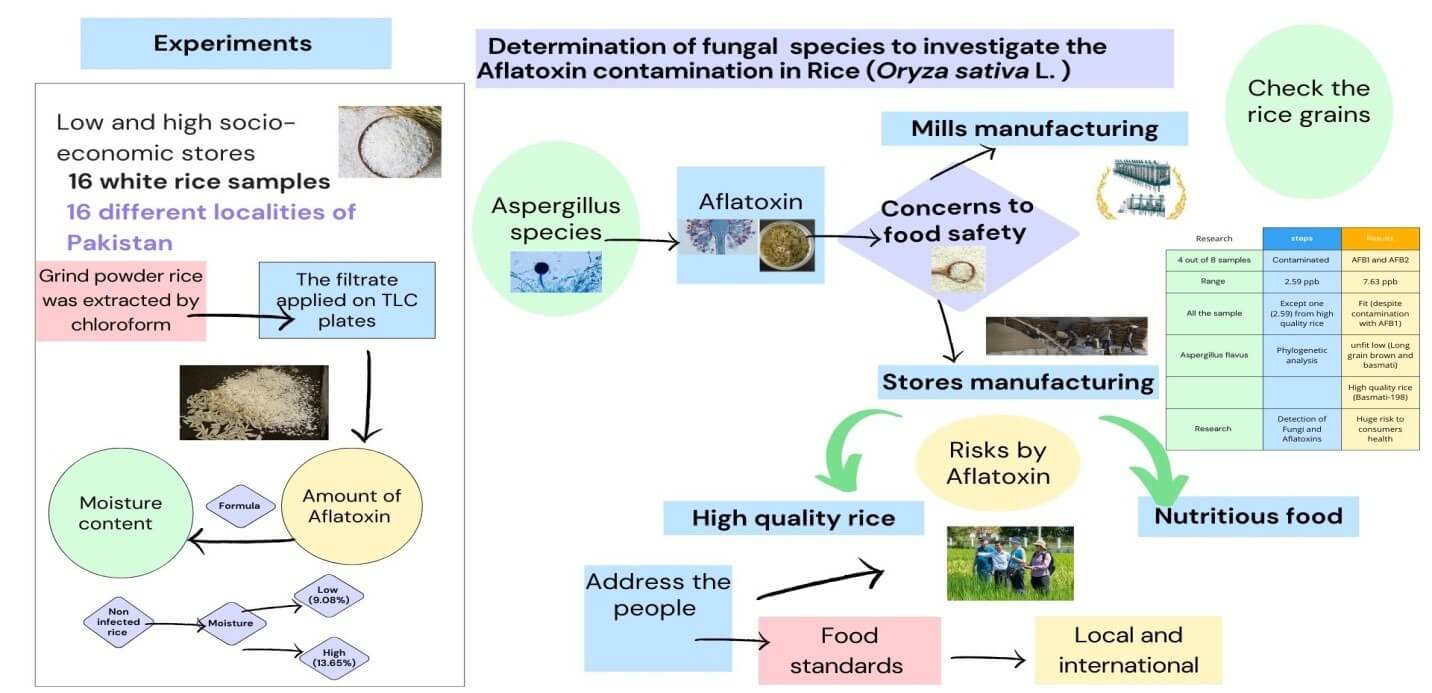 Open Access
Open Access
ARTICLE
Determination of Fungal Species to Investigate the Aflatoxin Contamination in Rice (Oryza sativa L.)
1 Department of Biology, College of Science, Princess Nourah bint Abdulrahman University, P.O. Box 84428, Riyadh, 11671, Saudi Arabia
2 Institute of Botany, University of the Punjab, Lahore, 54000, Pakistan
3 Department of Plant Pathology, College of Agriculture, University of Sargodha, Sargodha, 40100, Pakistan
4 Université de La Réunion, Laboratoire CHEMBIOPRO (Chimie et Biotechnologie des Produits Naturels), ESIROI Département agroalimentaire, 15 avenue René Cassin, Saint-Denis, F-97490, France
5 Department of Biotechnology, Adamas University, Barasat-Barrackpore Road, 24 Parganas North, Jagannathpur, Kolkata, 700126, West Bengal, India
6 Natural and Medical Sciences Research Center, University of Nizwa, Nizwa, 616, Oman
7 Department of Food Science & Technology, Faculty of Food & Home Sciences, MNS-University of Agriculture, Multan, 630496, Pakistan
* Corresponding Authors: Aisha Umar. Email: ; Yasir Iftikhar. Email:
Phyton-International Journal of Experimental Botany 2025, 94(2), 407-420. https://doi.org/10.32604/phyton.2025.058035
Received 03 September 2024; Accepted 14 January 2025; Issue published 06 March 2025
Abstract
Aspergillus species produce aflatoxins and raise concerns about food safety in departmental stores and manufacturing mills. To address the risks posed by aflatoxins, and to advise the public on the highest quality rice that serves as a nutritious food source, an inquiry following the guidelines outlined in both local and international standards of food safety for the presence of aflatoxins is an essential requirement. Therefore, 16 white rice samples were selected randomly from low/high socio-economic departmental stores from 16 different localities. Grind powdered rice filtrate was extracted using chloroform. The filtrate applied on TLC plates and the amount of aflatoxin and moisture contents were determined. In the non-infected rice, moisture content was low (9.08%) whereas high [13.65% > 12% (standard value)] in infected ones. Four out of 8 samples of low-quality rice were contaminated with AFB1 and AFB2 (ranging from 22.2 to 29.3 µg/kg). All the samples except one (22.3 µg/kg) from high-quality rice were certified fit despite the contamination with AFB1. Furthermore, phylogenetic analysis showed Aspergillus flavus from unfit low (Long grain brown and Brown basmati) and high-quality (Basmati-198) rice whereas A. parasiticus from unfit low-quality Medium-grain brown rice. The presented research proves that the detection of fungi and aflatoxins in rice grains poses a huge risk to the health of consumers. Therefore, it is necessary to check the rice grains before distribution.Graphic Abstract

Keywords
Cite This Article
 Copyright © 2025 The Author(s). Published by Tech Science Press.
Copyright © 2025 The Author(s). Published by Tech Science Press.This work is licensed under a Creative Commons Attribution 4.0 International License , which permits unrestricted use, distribution, and reproduction in any medium, provided the original work is properly cited.


 Submit a Paper
Submit a Paper Propose a Special lssue
Propose a Special lssue View Full Text
View Full Text Download PDF
Download PDF Downloads
Downloads
 Citation Tools
Citation Tools
